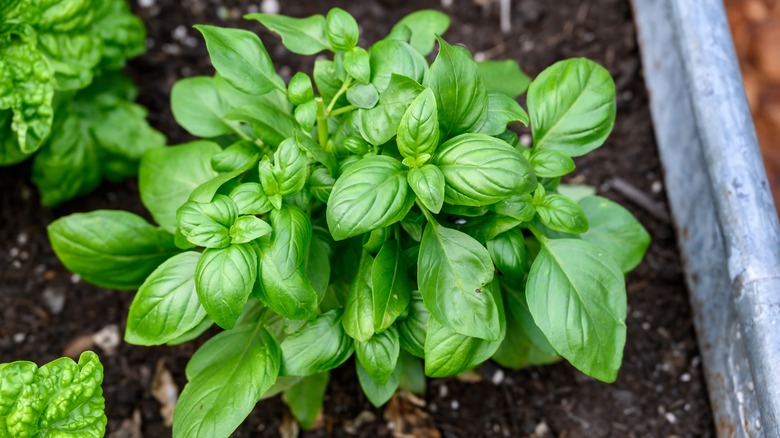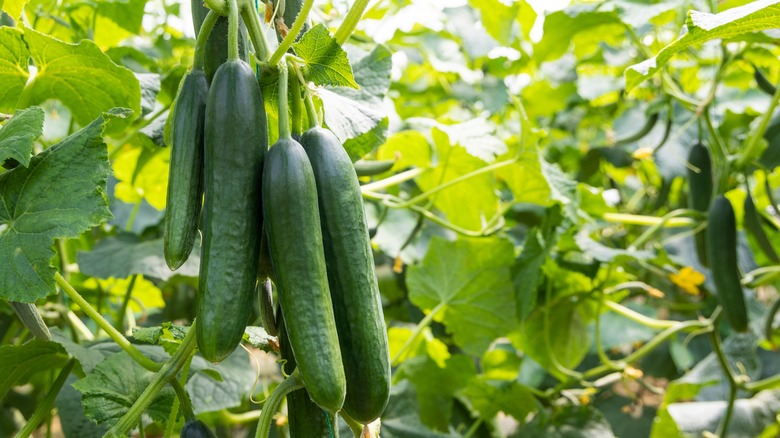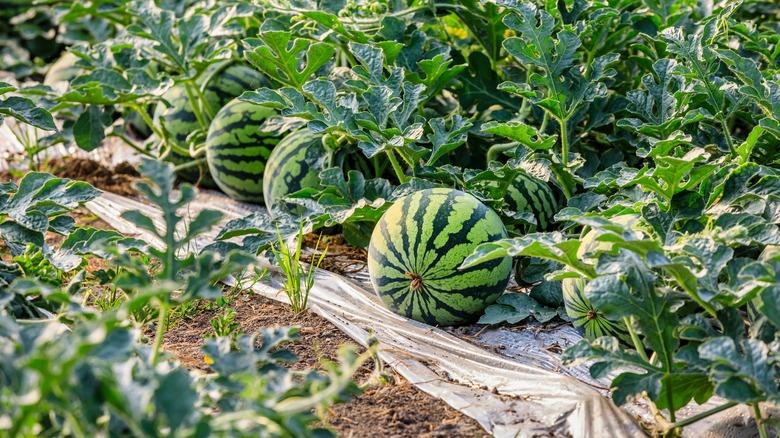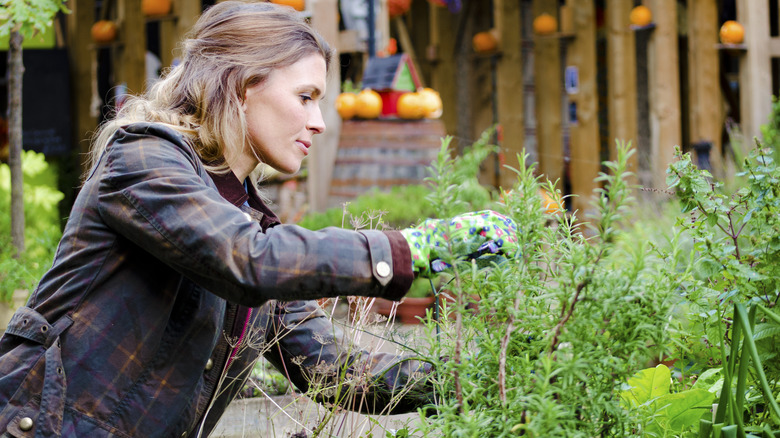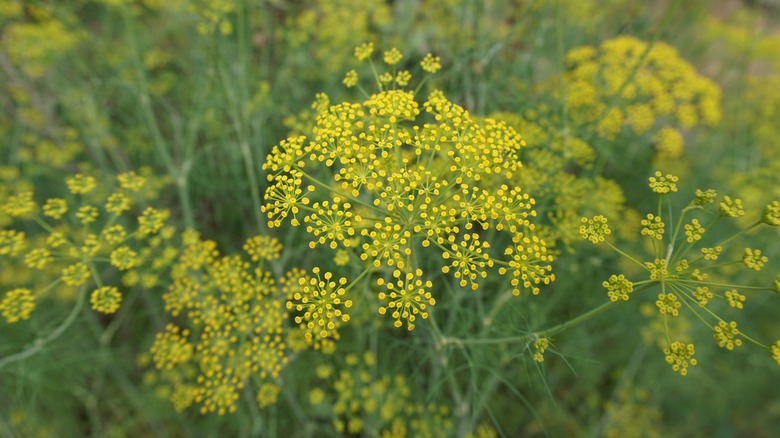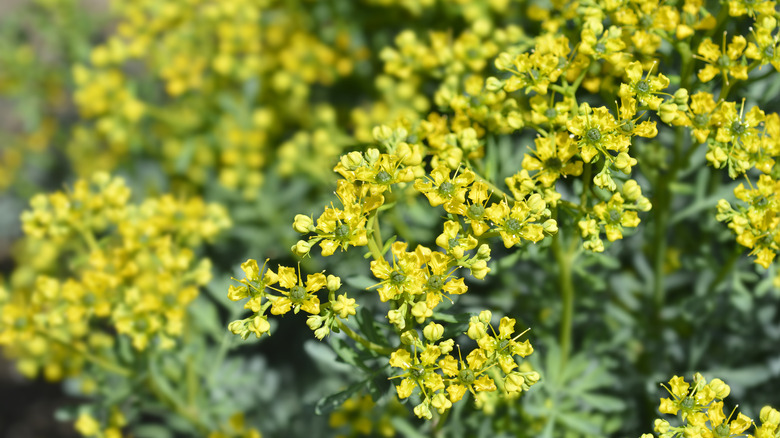5 Herbs And Veggies You Should Avoid Growing Near Basil In The Garden
Basil is a popular herb whose aromatic leaves provide healthy and delicious flavoring for many savory recipes. It's easy to grow and serves as a beneficial companion for several vegetable plants, including tomatoes, asparagus, and peppers. But there are a few plants that act as adversaries rather than companions to basil. For a variety of reasons, you should avoid placing these species near basil in your garden.
Companion planting can benefit your garden by allowing complementary species to help each other thrive. To optimize soil composition, nutrients, watering schedules, insect control, and spatial considerations, gardeners plan advantageous locations for plants that serve as beneficial neighbors for each other. Based on its anecdotal ability to repel thrips, flies, and mosquitoes, basil can be a great companion for many herbs and vegetables. Besides helping to discourage pests, basil can also attract beneficial insect species, such as pollinators and butterflies. Because of this, gardeners love to intermingle basil in vegetable beds or use it as a border. But in the case of common rue, fennel, and some other plants, it's best for basil to keep its distance. If you plan to grow basil in your garden, you'll want to know which plants should be placed far away from this aromatic herb. Read on to discover why certain species act as antagonistic neighbors to your basil bushes.
Cucumber vines will steal the water from your basil plants
Cucumbers are one plant you should never grow near basil. The fruits are 96% water, and this high water content poses several problems when basil and cucumbers are planted close together. First, the cucumber plant competes with the basil to drink up available water in the soil. It produces thick vines and a thirsty, sprawling root system. These qualities make the cucumber plant a vigorous competitor for resources. In consequence, your basil bushes will suffer. Secondly, the high water content in cucumbers makes them susceptible to taking on the flavor of neighboring plants. Due to the nature of basil as an aromatic herb, it influences the flavor of cucumbers when grown in close proximity. To enjoy the best-tasting cucumbers from the garden, you should avoid introducing the flavor of basil.
Planting basil and cucumber close together can potentially result in the spread of downy mildew disease, a problem that plagues both plants. Additionally, gardeners report a reduction in the harvest yield of cucumbers grown near the herb. The oils produced by aromatic herbs like basil are cited as inhibiting the vigorous growth of cucumber plants.
Instead of planting basil near cucumber plants, you might opt for alternative plants that serve as positive companions for cucumbers. These include cabbages, radishes, sunflowers, and bean species. The right companion plants for cucumbers can repel pests and offer support for vines, as well as improve the growth and taste of the fruit. If you're eager for bountiful herb yields, you can also employ techniques to harvest basil for more growth, such as nipping off the tops rather than picking the lower leaves, which can encourage spindly, leggy growth.
Melons and squashes can overpower basil bushes
Many people rejoice at the prospect of eating juicy watermelon, cantaloupe, and honeydew picked fresh from summer gardens. While these plants do not emit substances that harm basil plants, it's a good idea to provide plenty of space between the herb and any melons or squashes. These big ramblers take up lots of space and compete powerfully for available water and nutrients in the soil. Additionally, larger cucurbit plants can block the sunlight from smaller species. As a result, your basil bushes will come out on the losing side of the competition.
Consider the spatial needs of melons and squashes. Depending on the type, watermelon plants need between 3-12 feet of space to grow. Cantaloupe and honeydew plants require 3–4 feet all around. Summer squash needs 2–3 feet of space, while winter squash enjoys spreading out 3–4 feet.
Instead of growing basil next to these big crawlers, you might consider companion plants that provide soil enrichment and pest-repellent advantages for melons and squashes. Suitable companion plants for watermelon include beans, corn, camomile, pigweed, and summer savory. Melons enjoy the company of bush beans, collard greens, marigolds, and bee balm. If you're growing squash, you'll get good results by pairing the plants with peas, beans, radishes, dill, sunflowers, and nasturtiums.
Rosemary requires growing conditions that basil doesn't like
Many gardeners enjoy growing herbs close to each other in specialized herb gardens planted near the kitchen. There they can snip the fresh leaves and pop them into simmering stews, soups, and other delightful recipes. But there are some herbs you'll want to avoid growing close together, and rosemary and basil are two examples. Adequate drainage is a primary consideration for growing rosemary, as it thrives in dry soil, topping the list of drought-tolerant herbs. By comparison, basil likes soil that is consistently moist. When they're planted side-by-side in the ground, it's nearly impossible to provide the right growing conditions for both plants.
To solve the companion problem between basil and rosemary, you can grow both herbs in pots. There are many Mediterranean herbs that thrive in containers, and basil is one of them. By using pots, you can water the basil more frequently than the rosemary. Additionally, you might pay attention to the soil mixture for each plant. Be sure to provide a well-draining growing medium for the rosemary plant and a potting mix that holds moisture for the basil.
If you do plant rosemary in the ground, there are a few good companion choices that will thrive alongside the herb. These include other herbs like oregano, thyme, sage, and marjoram. Rosemary and lavender are also great companion plants in the garden. Grown as a positive companion for vegetables, rosemary pairs well with carrots, tomatoes, cabbage, and beans.
Fennel stunts the growth of basil when it's planted nearby
Fennel is an enemy of many garden plants, including tomatoes, peppers, eggplants, potatoes, beans, cucumbers, and basil. It's an allelopathic plant, producing a chemical that spreads through the soil to kill or stunt the growth of neighboring species. In a showdown between basil and fennel, it's the basil that will lose every time. It will fail to thrive when exposed to fennel's toxicity. On top of that, fennel attracts pests that enjoy feasting on basil, making it a particularly pesky neighbor.
If you want to grow fennel as an ornamental grass alternative or as a kitchen herb, find a location in the garden where the offending plant is at least 4 feet away from basil and other species that can be damaged by fennel's chemical emissions. Alternatively, you can grow fennel in pots to prevent the spread of the chemical that harms neighboring plants.
While it's an unfriendly neighbor for many vegetables and herbs, fennel does serve as a positive companion for some plants. These include peas, lettuce, and sage. The bulbs and seeds of fennel are a good source of vitamins, minerals, calcium, and fiber. That's why many gardeners opt to grow the plant. But for best results with growing basil, it's important to keep fennel at a distance.
Rue is a truly obnoxious garden neighbor for basil
Common rue poses insurmountable problems for basil when it's grown nearby. First, it's a bitter herb whose flavor transfers to the basil. As a result, the sweet-and-spicy yumminess of basil transforms into a bitter taste. You will not want to add the basil leaves to your recipes if it's grown near rue. Secondly, the rue attracts garden pests that attack the basil plants. At the same time, basil appears to become more susceptible to these pests under the influence of rue. This phenomenon leaves basil struggling when rue is grown in close proximity.
Rue is a perennial, pest-fighting companion plant with a long history of being used for medicinal purposes. While it's known to cause skin irritation and to be toxic if eaten in large quantities, rue does serve a purpose as a good neighbor for some plants. It repels Japanese beetles, aphids, slugs, snails, and flies. For this reason, rue is a successful companion plant for roses, figs, and raspberries.

